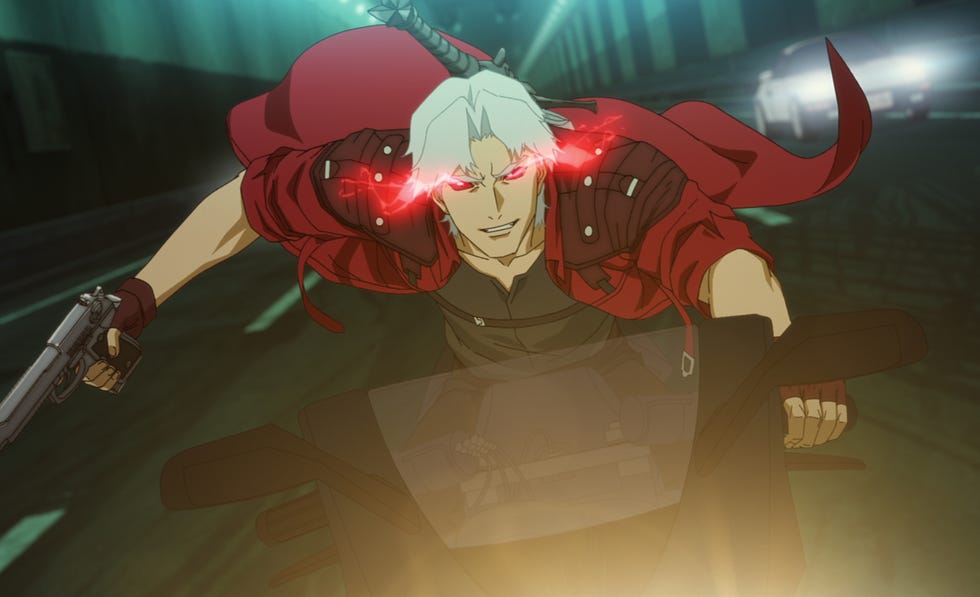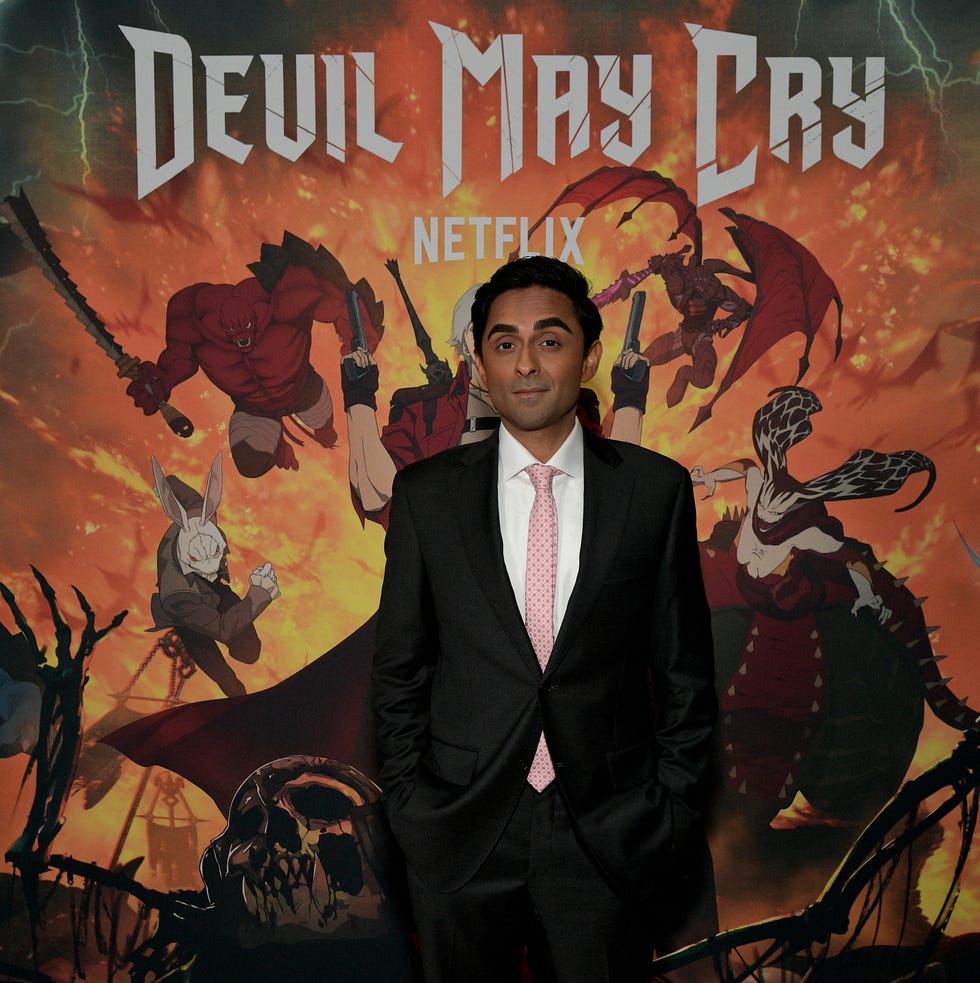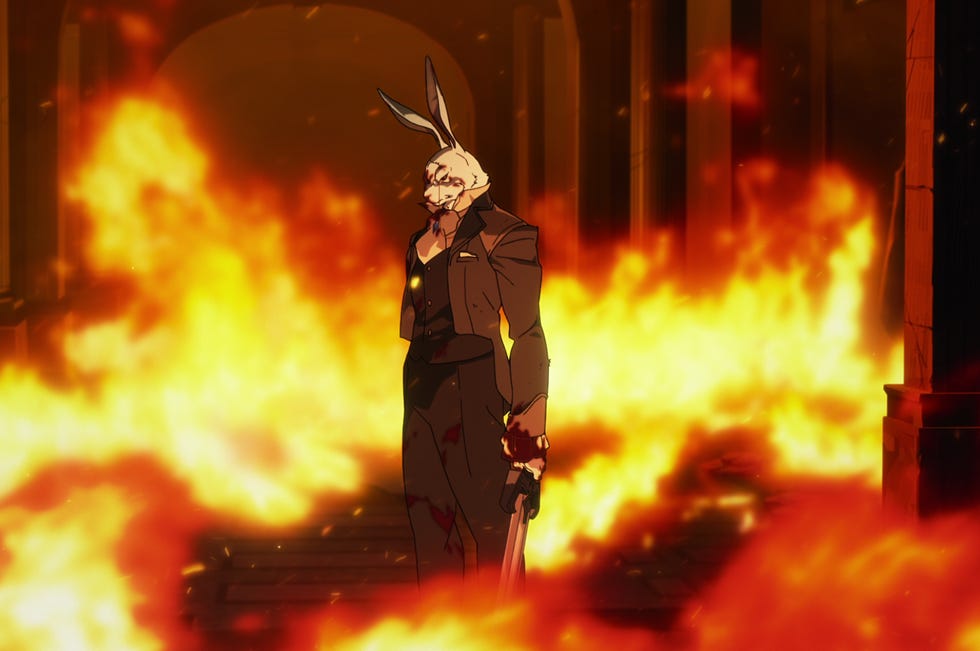Adi Shankar Has a Plan to Save Hollywood. But You Might Not Like It.
Adi Shankar moved to America just two days before everything went to hell. Following a nomadic childhood where his family changed homes constantly, pinballing from Kolkata to Mumbai to Hong Kong to Singapore, the future film and TV producer arrived in the states at age sixteen to attend boarding school in Rhode Island. Forty-eight hours after his arrival, the calendar turned to September 11, 2001. Suddenly, it was difficult growing up brown in America.
As an adolescent, Shankar latched onto the pop culture that reverberated through a war on terror: nu metal on MTV, reruns of action movies on cable TV, and Devil May Cry on PlayStation 2. As an adult, he found his footing as a Hollywood movie producer. His IMDB is full of gutsy dadcore fare starring names you'll surely recognize: The Grey (2011) with Liam Neeson, Killing Them Softly (2012) with Brad Pitt, Lone Survivor (2013) with Mark Wahlberg, and The Voices (2014) with Ryan Reynolds. It all led him to Devil May Cry, his latest animated series on Netflix. Although based on a major video game franchise from Japanese titan Capcom, Devil May Cry is quite personal, reflective of how Shankar "saw the world" in 2001. "Season 1 is about how we all lost something as children, and we spend the rest of our lives trying to reclaim it or find it or heal from it," Shankar tells me.

Devil May Cry, the newest animated series from Adi Shankar, premiered on Netflix in early April.
A week after Devil May Cry premiered on Netflix, Shankar sat ringside at WWE's Monday Night Raw. He dressed like his show's protagonist, Dante: a half-human, half-demon, all-too-cool bounty hunter thrust into saving the world by the U.S. government on the eve of Apocalypse. The getup (which he tells me was intentionally bad cosplay) consisted of a silver-white wig and a blood-red leather trench coat that reflected the lights of the T-Mobile Arena in Kansas City.
When the cameras pointed his way, Shankar didn't flash a smile. Nor did he wave with an overpriced beer in one hand. Instead, he silently pointed to the rafters—and to the heavens—in a manner evocative of hardcore wrestling legend Sabu, who died weeks later on May 11. "I wanted to be a professional wrestler," Shankar tells me, weeks later. "If you're a wrestler, you live the gimmick. It's a 360-degree art form."
It hardly surprises me that Shankar harbored wrestling dreams, because he's played the heel throughout his career. During his run making movies starring Neeson and Wahlberg, Shankar surfaced at red carpets in KISS-esque eye makeup, flowing raven hair, and rock star leather and denim. These days, you'll find him in a suit, but don't call him a sellout. "One of the things I've learned from wrestling is you have to keep reinventing yourself," he says, "Like when Chris Jericho dropped the long hair and became a riff on Javier Bardem in No Country for Old Men. There's evolution. What I'm trying to convey is that I am a generational fucking talent. I am the guy that can save Hollywood."

"There are shades of gray in my work because I don’t see the world as good versus evil," Adi Shankar tells Esquire. "There’s more nuance the more you get to know someone."
As his movies played on the big screen, Shankar broke the Internet in a way that sent comic book fanboys for a loop. The "Bootleg Universe," as he calls it, began as an anthology of gritty, adult-oriented, and very unofficial short films based on Saturday morning staples. It was shorts like The Punisher: Dirty Laundry (2012) and Venom: Truth in Journalism (2013) which dipped the Marvel heroes in pools of grime; and POWER/RANGERS from 2015, a viral phenomenon that interpreted the Mighty Morphin Power Rangers as shellshocked ex-child soldiers.
Since 2017, Shankar's work has been at home on Netflix, with dark yet faithful—and now official—animated shows based on video games. It started with the acclaimed Castlevania and continued with Captain Laserhawk: A Blood Dragon Remix. Soon, there will be Assassin's Creed, Hyper Light Drifter, PUBG, and more. These are not just shows, but battle plans for an overdue American animation revolution.
Maybe things would be different had Adi Shankar not followed in the literal footsteps of one of his heroes: the aforementioned Sabu. "My parents were like, 'You need to go into finance,'" he remembers. "I was interviewing at CitiBank. I was in a suit. I'm in JFK waiting for my flight to Chicago." Standing there was Sabu. "I'm like, 'Hey, you're Sabu.' He's like, 'Who are you? Are you a narc?' He didn't know if I was real or not. [Sabu says] 'Come with me!' I follow him around. That made me realize I'm not going to do finance. I'm around other business types in business suits, and Sabu was more interesting."
Below, Shankar unloads on the making of Devil May Cry, what's next for the Bootleg Universe, and why American animation needs a kick in the ass.
This interview has been edited and condensed for clarity.
ESQUIRE: Of all the franchises in Capcom's catalog, what drew you to Devil May Cry?
ADI SHANKAR: Capcom suggested DMC. Castlevania was coming out. I showed up to a meeting with Capcom—I remember because I used to wear makeup and costumes, that was my gimmick then—and I wouldn't stop talking about Dino Crisis. [I said] "I want to bring back Dino Crisis." I was dressed like a character from Devil May Cry. They start whispering in Japanese, and they're like, "What about Devil May Cry?" I was like, "Yeah, I'm in."
Just like that?
It was immediate. I didn't realize Devil May Cry was on the table. I didn't want the biggest thing. Don't give me Street Fighter or Assassin's Creed. I was a fan of so many things that disappeared and I was in a position of power to bring them back. I could make more Dino Crisis! And if I blow up Dino Crisis into Jurassic Park, I should do that. I was also inspired by Devil May Cry. I've been a fan since 2001. There was just a part of me that didn't want to tip my hand how much I liked it.
You cast Johnny Yong Bosch as the voice of Dante. He's also in the games as the voice of Nero. What made you see him as Dante?
It happened at Power Morphicon. [Editor's note: Power Morphicon is the biennial Power Rangers fan convention.] After the Power Rangers short dropped, I had frat guys coming up to me like, "Dude! Yes!" I assumed it was universal acclaim and I was this beloved guy—not realizing I was going to a hardcore audience who were horrified they allowed me in the venue. Someone said, "You're brave for going there." I don't fucking back down, so I'm definitely going. But in my head, I'm like: Am I John Cena at ECW One Night Stand? Minutes before I go on stage, [ex-Power Rangers stars] Steve Cardenas and Johnny walk in like, "We'll go on with you."
We went to an afterparty. I sat in a corner talking to Johnny about his line in the Power Rangers movie where he says, "I'm a frog." He morphed into Dante as I was talking to him. Before Netflix was on board, I sent someone to his house with a briefcase. It's the outline for DMC season 1. This is all theatrics because I thought it was funny. He didn't know what was going on.
I'm making American animation fucking cool. That's what I'm doing.
Devil May Cry has a nu metal soundtrack that evokes 2000s nostalgia. Limp Bizkit's "Rollin'" is the theme song, and you've got Papa Roach, Rage Against the Machine, a new song by Evanescence.
At its core, Devil May Cry is melancholic—a rock 'n roll Shakespearean tragedy. That is nu metal. It's loud and screamy but with a pop sensibility. The hooks of nu metal were catchy, that's why they work as acoustic songs. Nu metal felt like a dance between fate, loss, and the pursuit of redemption. There was this nu metal boom and the world was changing. It's alchemizing all these elements together, to create a new DMC universe on Netflix. That's why it fits.
I want to highlight episode 6 of Devil May Cry. It's a mostly nonverbal episode until the end, and it deals in political allegories with the plight of demonic refugees.
Devil May Cry was loud and in-your-face. My show captured that. Episodes 1 to 5 are a Hollywood blockbuster from 1997 to 2003. It's The Crow. It's Underworld. It's Bad Boys. Take the volume from a ten to something that will blow out the speakers. But I like playing in contrast. Sometimes, you can make the loudest statement with no words. If you look at the Parkland shooting, there was a big rally around it–and maybe this inspired it–everyone was giving speeches, but one student got on stage and said nothing for five minutes. In a forum of speeches and activism, the silence said the most.
When you're a kid dealing with chaos, it is loud. I wanted you to feel for these characters. Any good villain, any human being, is the hero of their story. There is logic and narrative justifying [them]. They don't go, "I'm going to do villainy." They're going, "I'm the hero." I wanted to put you in the shoes of the White Rabbit. There's that quote, "Walk a mile in someone's shoes, you become them." Coupling that with the idea that trauma is an imprint, a fracture in time, something the psyche never stops trying to mend. When a part of the child dies through heartbreak, the adult self is sentenced to an unending quest to reclaim what was lost. That shapes them in ways they may not understand.

The White Rabbit, voiced by actor Hoon Lee, is a major antagonist in Shankar’s Devil May Cry. His origin story is the focus of episode 6, a mostly nonverbal episode that reveals his plight as an advocate for demon refugees.
So much of your work deals with traumatic childhoods. You've mentioned before that you had a difficult upbringing.
There is a narrative throughline about the manipulation of the youth. So much of what I do is about propaganda. My family kept moving to different countries, different societies with different values and languages. You get no cultural stability. There are no fixed points. When you're moving around as your mind is forming, nothing meant anything. What was "cool" was shifting. "Cool" was a construct that was malleable depending on where you were. Even the history books were different. You learn about the American Revolution here—it's not considered the American Revolution in a British school. It's an American revolt.
What is your grand plan for the Bootleg Universe? What is missing in animation that you're trying to fill with it?
I'm trying to make animation cool in the way hip-hop became cool. The way Kanye changed fashion. The way Virgil Abloh changed luxury. I don't think it's definable. Hyper-commercialism—things designed to sell toys—that's Western animation. Hanna-Barbera is cute, but it's not cool. Anime is cool. I watched this transition happen, where it was geeky and all of a sudden Travis Scott is talking about Dragon Ball. I'm trying to do that for America. Why is Japanese animation cool? Why is an NFL athlete doing a Dragon Ball dance? Where's the American influence? American animation is stuck in kidland.
Devil May Cry is not anime. It's in the lineage of X-Men, Batman: The Animated Series, Gargoyles, and UltraForce. I grew up on action-heavy Saturday cartoons. American Saturday morning cartoons were fucking sick. I didn't even live in America and I watched them! They made me want to be here. But they were boxed in by broadcast standards, and I wondered what these stories would become if they weren't held back. That's the space I'm building. Carry forward the language of the era and elevate it for an audience grown up but still craves that style and energy. I'm not chasing the grammar of anime. I'm building something new rooted in American action storytelling. This genre needs a name, because it's not anime. It's something that lives between Saturday morning cartoons, prestige television, and R-rated cinema.
Many Americans see animation and think of it as a kids' thing. They never think of someone like [arthouse animator] Don Hertzfeldt.
It's arthouse. Miyazaki does cross over [with adults and children], but to an American, that's still arthouse. The audience going "Woah!" with Cody Rhodes is not watching Spirited Away. There's a broadness [that] animation needs to be cool. Like nu metal. When nu metal was the coolest thing, the hits are what made it. They took nu metal but distilled it into a poppy frame so everyday people were like, "I'm into this." Korn's "Freak on a Leash" becomes a Trojan horse for normal people to get into Deftones and Tool.
American animation doesn't have that. You have people stuck in Hanna-Barberaland. It's cool to me, but it's not cool to the NFL player pretending to be Goku. They're not going "Yabba Dabba-doo!" It's not fucking happening. That's my influence. I'm making American animation fucking cool. That's what I'm doing.

Shankar, dressed as Devil May Cry’s Dante at WWE Raw in April. "Wrestling is a form of theater," he says. "But wrestlers take their jobs home. They live the gimmick."
What do you have coming next?
I got video games in production. Obviously more Devil May Cry. I'm being approached with different IPs and companies that want to work with me. I bought the rights to Duke Nukem. Not the gaming rights, but I bought it from Gearbox.
What's your vision for Duke Nukem?
It's a middle finger to everybody. When Duke Nukem blew up, a bunch of people sat around trying to turn it into a brand, when it's just a middle finger. Duke Nukem can't be made by a corporation, because the moment a corporation makes Duke Nukem, it's no longer Duke Nukem. I don't intend on having anyone tell me what to do on this one.
What are your plans for Devil May Cry season 2?
My plan was always to build and expand Devil May Cry. Season 1 had to be the gateway drug, but season 2, the storytelling is going to pivot. Season 2 is going to be different, stylistically and tonally, from season 1. Virgil is a big, very important character. It's essentially a new show.
I have goals. I want to body Arcane, surpass it in viewership... Arcane is the Joker lighting cash on fire, and it's great. With season 2 of Devil May Cry, I want to beat that. Show up to a tank fight with a water balloon and destroy the tank. Because that's cool.
esquire




